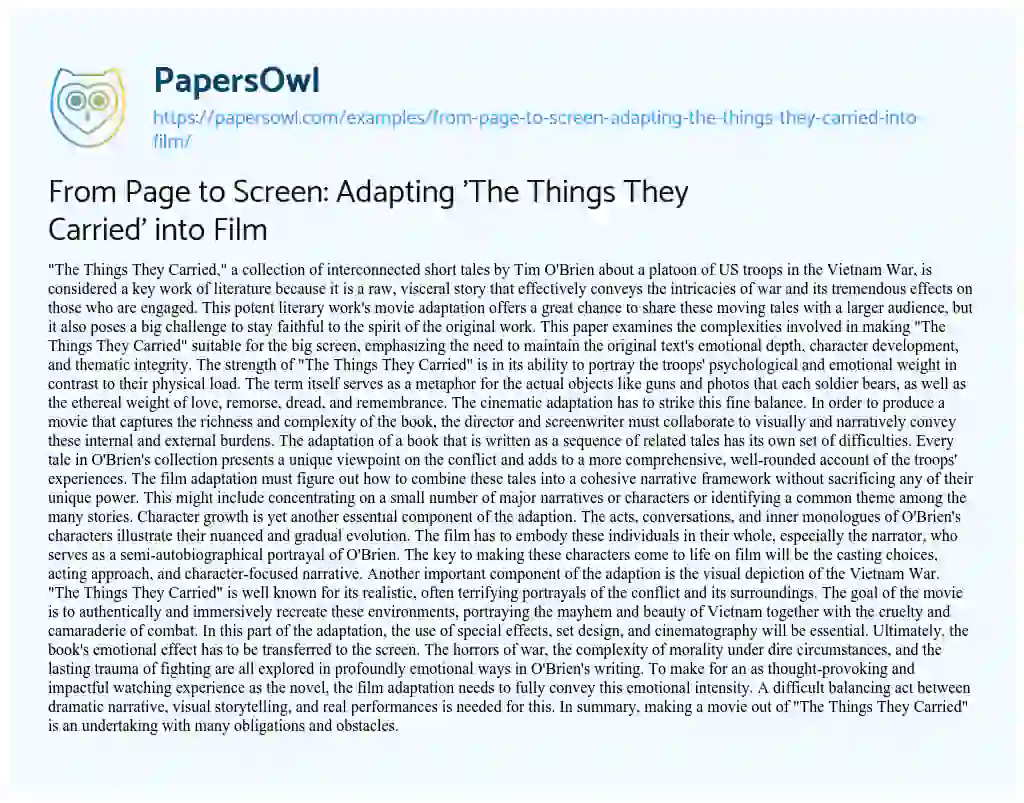From Page to Screen: Adapting Adventure Novels for Cinematic Success

From Page to Screen: Adapting Adventure Novels for Cinematic Success
The rustling pages of an adventure novel, the scent of old paper, the thrill of a perilous journey unfolding – these are experiences uniquely tied to the written word. Yet, the siren call of the silver screen beckons, promising to translate these literary adventures into vibrant, visceral cinematic experiences. But the transition from page to screen is rarely seamless. Adapting an adventure novel for cinematic success requires a delicate balance of faithfulness, creative license, and a shrewd understanding of the distinct languages of literature and film.
The Challenges of Translation: From Prose to Pictures
Adventure novels, by their very nature, rely on the power of evocative description, internal monologue, and intricate plotting. Film, conversely, thrives on visual storytelling, action sequences, and emotional immediacy. This fundamental difference creates a significant hurdle for any adaptation. The richness of internal thoughts, the subtle nuances of character development meticulously crafted over hundreds of pages, must be conveyed through visual cues, dialogue, and carefully constructed scenes. The expansive landscapes of the imagination must be realized within the constraints of a budget and shooting schedule.
One of the most significant challenges lies in condensing a sprawling narrative. A 500-page novel might encompass years of a character’s life, complex subplots, and intricate world-building. A two-hour film necessitates ruthless prioritization, focusing on the core narrative arc and sacrificing some elements for the sake of pacing and coherence. This process requires a delicate touch, avoiding the pitfalls of simplification and ensuring the essence of the story remains intact.
Navigating the Narrative Landscape: Key Adaptational Strategies
Successfully adapting an adventure novel demands a nuanced approach, informed by a deep understanding of both the source material and the cinematic medium. Here are some key strategies employed by successful adaptations:
1. Reframing the Narrative: Instead of a scene-by-scene replication, adaptations often necessitate a reframing of the narrative. The core conflict and character arcs are retained, but the structure might be altered to enhance its cinematic impact. Nonlinear storytelling, flashbacks, and dream sequences can be used to enrich the cinematic experience.
2. Visualizing the Unseen: The power of suggestion in literature needs to be replaced with explicit visual representation in film. The inner turmoil of a character, for instance, needs to be conveyed through actions, facial expressions, and visual metaphors. Similarly, the expansive landscapes must be brought to life through stunning cinematography and location scouting.
3. Streamlining Subplots: Often, intricate subplots, essential to the novel’s thematic depth, need to be streamlined or even excised to maintain narrative focus. This involves discerning which elements contribute to the core conflict and which can be sacrificed without compromising the integrity of the story.
4. Amplifying the Action: Adventure novels often feature detailed descriptions of action sequences. Film takes this a step further, relying on visual spectacle and visceral thrills. Choreography, special effects, and editing techniques are crucial to create impactful action sequences that capture the intensity and excitement of the written descriptions.
5. Character Development through Visual Storytelling: The internal lives of characters are vividly portrayed in novels through extended descriptions and internal monologues. Film needs to find visual equivalents: a character’s haunted expression reflecting past trauma, or a subtle gesture betraying their inner conflict.
Case Studies: Successes and Failures in Adaptation
| Novel | Film Adaptation | Success Factors | Challenges Faced |
|---|---|---|---|
| The Lord of the Rings | The Lord of the Rings Trilogy | Faithful adaptation, spectacular visuals, strong cast | Lengthy source material, complex world-building |
| Jurassic Park | Jurassic Park | Effective translation of core concepts, suspenseful pacing | Maintaining the book’s thematic depth |
| The Hobbit | The Hobbit Trilogy | Visual spectacle, world-building, character designs | Pacing issues, deviation from source material |
The Future of Adaptation: Embracing New Technologies
Technological advancements are further blurring the lines between literature and film. VR and AR technologies offer immersive storytelling experiences, allowing audiences to become active participants in the adventure. The future of adaptation might involve interactive narratives, personalized storylines, and experiences that bridge the gap between the reader’s imagination and the director’s vision. The core principles, however, remain the same: a deep understanding of the source material, a creative vision, and a commitment to translating the spirit of the adventure from page to screen.

Additional Information
From Page to Screen: A Deeper Dive into Adapting Adventure Novels for Cinematic Success
The adaptation of adventure novels for the screen presents unique challenges and opportunities. While a compelling narrative forms the foundation, successful cinematic translations require a nuanced understanding of how to translate the novel’s strengths while mitigating its inherent limitations. This deeper dive will explore key considerations beyond a simple plot synopsis, focusing on narrative structure, character development, visual storytelling, and the commercial realities of the adaptation process.
1. Narrative Structure: From Linearity to Cinematic Pacing:
Adventure novels often rely on linear storytelling, meticulously detailing the protagonist’s journey. However, cinema demands a more dynamic, visually driven approach. Direct translation often leads to a sluggish pace. Successful adaptations employ techniques like:
- Parallel Editing: Intercutting multiple storylines increases tension and reveals character motivations more effectively than a purely chronological approach. Consider the effectiveness of parallel editing in the Lord of the Rings trilogy, where the Fellowship’s journey is interwoven with Sauron’s machinations.
- Nonlinear Narrative: Flashbacks and foreshadowing, judiciously used, can heighten suspense and provide crucial contextual information in a concise manner. Memento serves as an extreme example, but even more conventional adaptations use this technique for impactful storytelling.
- Focus and Condensation: Inevitably, some plot elements must be sacrificed. Prioritizing key plot points and character arcs, while eliminating superfluous details, is crucial. The adaptation of The Hobbit faced criticism for stretching a relatively concise novel into a trilogy, demonstrating the risks of over-expanding source material.
2. Character Development: From Internal to External:
Adventure novels often delve deeply into a character’s inner life, relying heavily on internal monologues and detailed descriptions of emotional states. Cinema, however, prioritizes external actions and visual cues. This necessitates:
- Visualizing Internal Conflicts: Internal struggles must be conveyed through body language, facial expressions, and interactions with other characters. The portrayal of Aragorn’s internal conflict between duty and personal desires in the Lord of the Rings provides a powerful example.
- Condensing Character Arcs: Extensive backstories need to be streamlined, often using visual shortcuts like flashbacks or concise dialogue exchanges. The successful adaptation of complex characters like Katniss Everdeen in The Hunger Games demonstrates the necessity of finding cinematic equivalents for the novel’s intricate character development.
- Elevating Supporting Characters: While novels may feature numerous supporting characters with nuanced roles, adaptations usually prioritize a smaller cast. Therefore, carefully selecting and expanding the roles of key supporting characters can enhance the overall cinematic experience.
3. Visual Storytelling: Translating Description into Image:
Adventure novels are rich in descriptive passages, painting vivid pictures of landscapes, environments, and action sequences. This descriptive power must be translated into compelling visual language:
- Location Scouting and Production Design: Finding locations that authentically capture the novel’s setting is crucial. The success of films like The Lord of the Rings and Game of Thrones largely rests on their commitment to visually stunning locations.
- Special Effects and CGI: While CGI can enhance visual spectacle, overreliance can detract from the story’s emotional impact. A balance must be struck between practical effects and digital enhancements. The visual effects in The Jungle Book demonstrate how effective integration of CGI can seamlessly blend reality and fantasy.
- Composition and Cinematography: The visual framing and movement of the camera are crucial in guiding the audience’s attention and conveying the emotional tone of the scene. The distinctive cinematography of films like Pirates of the Caribbean contributes significantly to their cinematic appeal.
4. Commercial Considerations: Genre Conventions and Audience Expectations:
The success of an adaptation also hinges on understanding market demands:
- Genre Conventions: Adventure films often adhere to established genre conventions (e.g., a clear hero’s journey, satisfying resolution). Deviation from these conventions can alienate audiences, even if the novel itself is unconventional.
- Target Audience: Adaptation decisions should consider the target demographic. A children’s novel adaptation will require different considerations than a complex adult novel.
- Box Office Potential: Studio involvement often necessitates a focus on commercial viability. This can lead to compromises in artistic vision, but successful adaptations demonstrate that commercial success and artistic merit aren’t mutually exclusive. The Harry Potter franchise serves as a compelling example of balancing artistic vision with blockbuster appeal.
Case Study: The Lord of the Rings Trilogy:
Peter Jackson’s Lord of the Rings trilogy stands as a benchmark for successful adaptation. While it involved significant condensation and alteration of the source material, it deftly translated the epic scope, complex characters, and thematic depth of Tolkien’s work into a compelling cinematic experience. Its success highlights the importance of meticulous planning, a strong creative vision, and a commitment to both fidelity to the source material and cinematic innovation.
In conclusion, adapting adventure novels for cinematic success requires a multi-faceted approach encompassing narrative restructuring, character refinement, visual storytelling, and a keen understanding of audience expectations and commercial realities. Successful adaptations are a testament to the skillful balancing act between fidelity to the source material and the unique demands of the cinematic medium.

